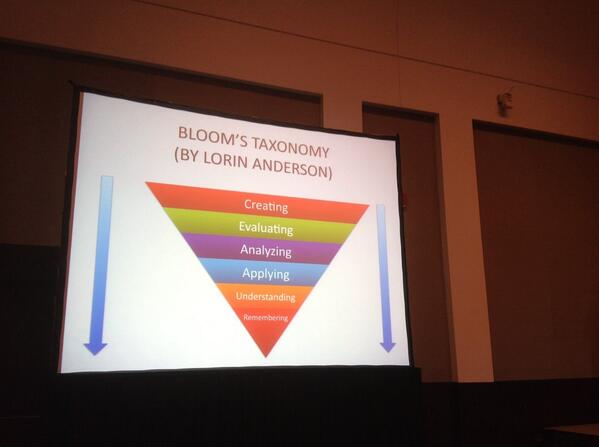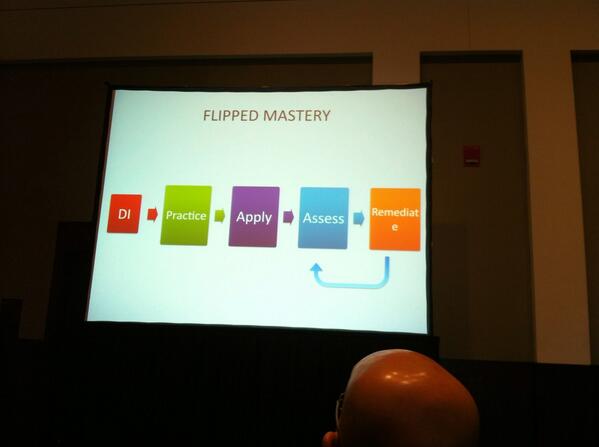Featured speaker, Jon Bergman, starts out by saying that he's going to talk more about pedagogy than iPads because why use a device if there isn't strong pedagogy behind it. He grew up being a learner and in a family of learners. When Jon first started teaching, the only technology that he had was the chalkboard. However, after a few years, his next tool was "the overhead projector." Eventually, he got a computer and a projector, but the teaching practice all looked the same.
"Do our students know anything different than asking Siri?" Asks Jon. We are in exciting times where we need to move to the project-based, inquiry-based classrooms, but we "have school backwards where we send kids home to do the hard stuff." Cognitively, applying and creating is the difficult task that we ask students to do at home. What if we flipped Bloom's Taxonomy upside-down so that students are creating, evaluating, analyzing, and applying in school and working towards understanding and remembering at home.

When students have the support at home to help with the taxonomy, then a traditional model may be fine. However, what happens when the support isn't at home. With flipped classroom, the more difficult cognitive tasks happen when the students are present with the expert - the teacher.
Flipped is not a top-down idea. It started with real teachers in real classrooms. Jon thinks that bottom-up change works, though it needs support from the top. In real systems of change, there are grass-roots movements that are supported from the top. Jon says, "Good teaching should be, and will always be, about relationships." Given that, can we use technology (iPads) to increase relationships and build connections?
What's the best use of face-to-face classtime?
When Jon first started with flipped, he wanted to do more projects and have more hands-on time. For each discipline, it needs to be about less sitting-and-getting and more about learning by doing. To really illustrate this, Jon challenged all of us to fill in this one-question survey which he then will generate into a WordCloud. Key terms included: STUDENTS, challenged, problem, project.
"No mention of lecture" says Jon.
What is the Flipped Class? - Myths & Misconceptions
Sometimes, at the beginning, teachers thing that the focus is on the videos. However, Jon says that it's really about the creation of learning objects for students to consume at home in order to acquire content. It's also important to think about the Digital Divide - don't forget about students without access.
According to Jon, Flipped Class is a synchronous environment where all students work at the same case. With Flipped Learning, teachers will flip for 1-2 years before going deeper and incorporating inquiry-based learning, project-based learning, challenge-based learning, and Universal Design for Learning in order to move towards Mastery.

From Flipped Class to Flipped Learning
Flipped learning is a crazy, active, messy time. However, students become independent learners. A great benefit that Jon discovered with this was the ability to differentiate learning because it "freed up the teacher from the front of the room." A final benefit was that Flipped Learning left no where to hide. Every student could be addressed every day.
In many ways, Flipped is a transitional method for leading teachers towards a more student-centric classroom. For a teacher who has always done direct instruction, Flipped is a great stepping stone in that it can begin by recording lecture and move forward from there. Similarly, with iPads, Jon says that it can be a "subterfuge method" by incorporating iPads. It shows that both teachers and students can become creators. He addresses this more in his blog post, Why You Should Flip Your PLC?
A few Tech Tips for Flipping
From a technical perspective, one key to creating quality videos is to bring in an inquisitive student. If you don't have a real person, create a virtual one with Tellagami or another app. While it does seem like extra work, the key is that you only have to do it once. However, as Jon says, "the biggest hurdle to flipping the class is actually flipping your mind."

